Monday, 9 July 2007
Distance 32 km
Duration 6 hours 20 minutes
Ascent 176 m, descent 254 m
Map 64 of the TOP100 blue series (now superseded)
Map 57 of the TOP100 blue series (now superseded)
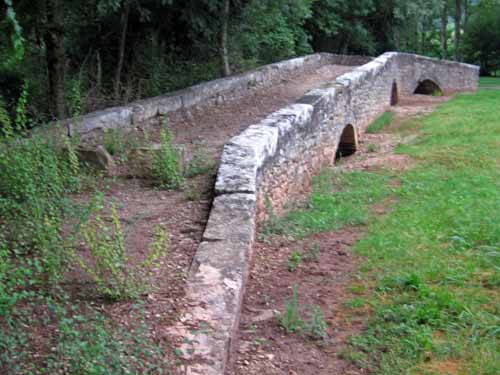
When we woke up the rain had stopped, making our morning preparations much easier. We were still the only occupants of the camping ground but we felt that the good people of Laval, who had tended it so carefully, were with us in spirit. By 7 o’clock we were down on the highway.
The choice was between the GR46, which climbed to the pinnacle of the village and continued northwards over a wooded ridge to the Aveyron, and the road, which followed the little river we had been on since Castelnau-de-Montmiral (the Vère) to its confluence with the Aveyron. Obviously plan B would be gentler in gradient and we could not imagine a medieval traveller going any other way.
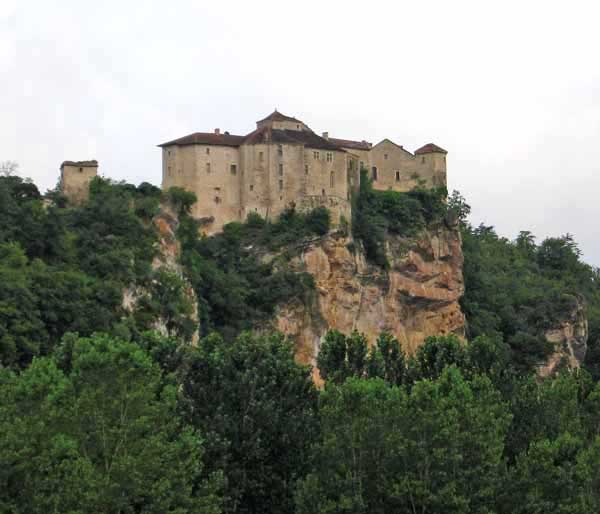
It was a variation of the well-known adage that the devil has all the best tunes – in France the roads have all the best routes. Added to that, the GR track would be muddy and the forest dripping. It was still early and we could be at the Aveyron before the traffic got going.
We made great time along the valley, which was almost a gorge at first. A few trucks were our only companions on the road. At Larroque we hoped for a bar, and there was a bistro there, but not an open one, as it was too early.
In the next uneventful hour or so we left the department of Tarn and entered Tarn-et-Garonne, not that it made any difference, and approached the third of the Plus Beaux Villages, Bruniquel, hanging on a crag above the Aveyron.
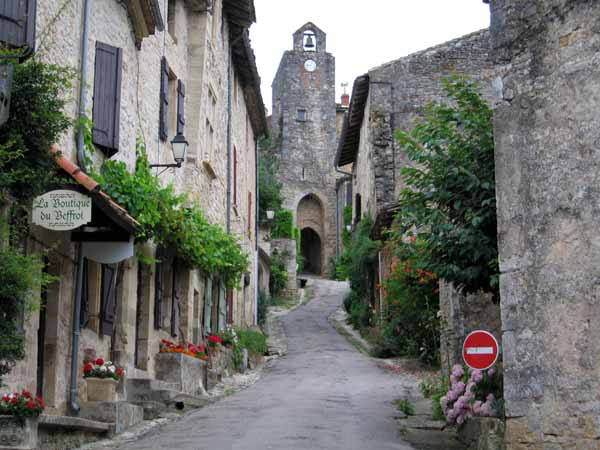
Having crossed the Vère, we found ourselves climbing a succession of steep lanes towards the church and belfry on the summit. It was an utterly charming little place and it had various gift shops, but we were after something more nourishing than a postcard.
I asked a woman passing by whether there was a bar in the town and she replied that she was wondering the same thing. The man in the gift shop pointed to an ugly modern building, all alone at the base of the village. This was confirmed as the only bar in town by a couple of hefty local women on the street.
The bar was delightful once we got there. As it was Monday, there were no croissants to go with our coffee, but we made do with the last of yesterday’s bread and some jam that we had been carrying ever since our hotel breakfast in Saint-Chély-du-Tarn, so long ago.
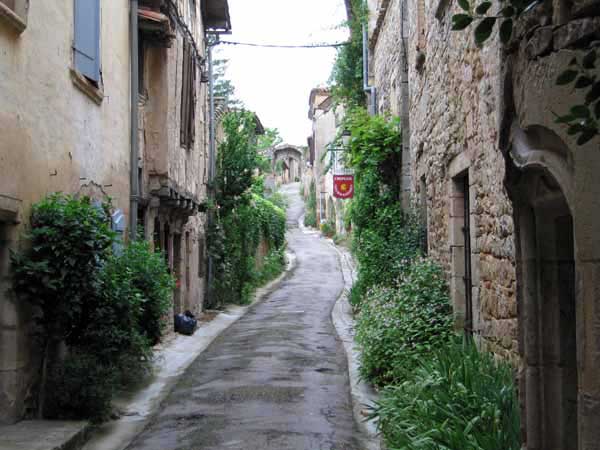
The front page of the Dépêche du Midi carried a picture of a deserted beach with two or three people bent over in raincoats, their umbrellas inside-out.
The helpful barman explained how to connect with the back road to Montricoux and it turned out to be a beautiful walk through open fields.
On a small bridge there was a shocking plaque to a lad shot there by the retreating Germans in 1944, and further on a little monument, decked with flags, to four young locals who had met the same fate. We had forgotten the tragic recent history of France, not having seen signs of it lately.
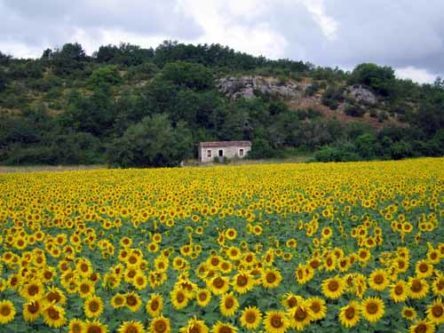
As we came level with the substantial village of Montricoux, it occurred to us that we did not really need to visit it.
We could already see its squat tower and multi-faceted church steeple from across the river and it would be quite a deviation to get any nearer. After our second breakfast in Bruniquel we still had the energy to continue.
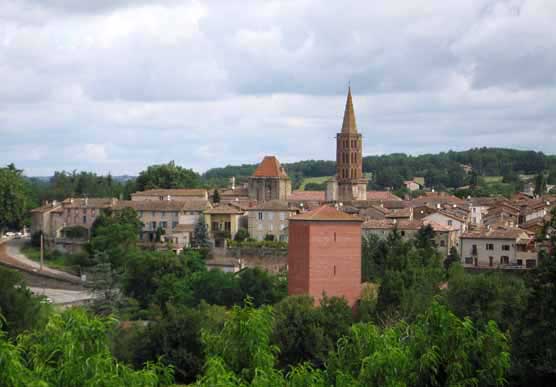
We kept going along the left bank, crossed the highway and continued our pleasant ramble through the fields past lovely old farmhouses, some with pigeonniers attached.

Not far from Nègrepelisse was a sight that could surely only be seen in France – a field of flowers in unregulated profusion, stretching far away towards a farmhouse. It was not a commercial crop, but an example of the Jachères Fleuries (flowering fallows) that had sprung up all over the country in the last ten years.
Uncultivated land, thickly sown with annuals, provides a refuge and food source for countless insects, birds and small animals, as well as shelter for native plants.
The movement was actually started by hunters wanting to increase the number of furred and feathered targets for their guns, but had been taken up enthusiastically as a conservation project by the French population, and was now a source of pride.
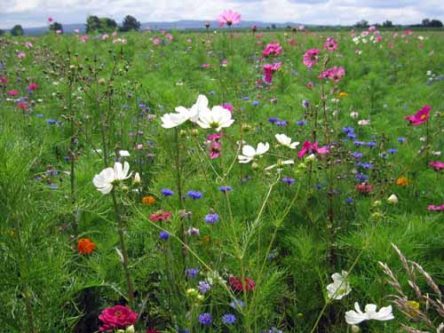
Nègrepelisse was a fairly large village that was suffering after being bypassed by the highway. The old main street and graceful square had many closed shops, while there was a strip of new shops along the highway.
We had coffee under an arcade looking onto the square. As it was Monday, both the boulangeries were closed, but, predictably, the one out on the highway was doing a brisk trade.
We had lunch on a seat in the square. Although there was a camping ground in the village, we decided to go the extra seven kilometres to Albias, as it was only 1 o’clock and rather cool and cloudy. It even rained a bit before we set off.
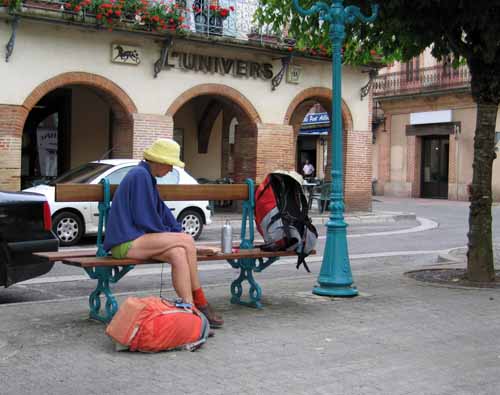
The walk was perfectly flat and easy, through huge apple orchards veiled like brides in white muslin.
At one house we were bailed up by a snarling dog, but such animals no longer gave us trouble. Keith took the bag of tent poles from the pocket of his pack and advanced, waving it menacingly, with the desired result.
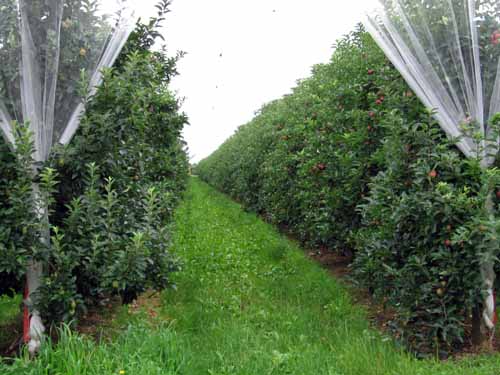
At the entry to Albias we followed a sign to the camping ground, which was a little way along the Aveyron. At first glance it looked run-down and deserted, but in fact the caravans and tents were behind the shower block.
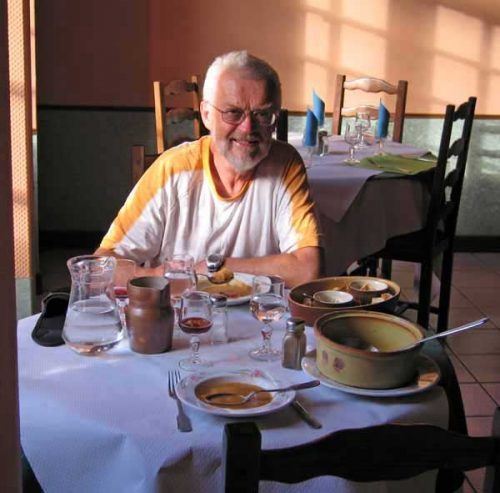
We picked a place on the riverbank, put the tent up quickly because of the threatening weather, and retired to sit under a tree.
Our neighbours were a group of fishermen with a dog, and we saw them roaming about near our tent with a shovel, staring at the ground, as if prospecting or looking for a lost ring.
We eventually realised that they were very politely picking up their dog’s droppings from our area and dropping them in the river.
In the course of the afternoon we had sun, rain, wind and cold in quick succession.
At 7:15 we made the trip to town, about a kilometre away, in search of dinner. Unlike Nègrepelisse, it was flourishing, as the N20 from Montauban went through it, and it also had a railway station. Even so, two of the three restaurants were closed – the familiar Monday problem. Only the hotel was open.
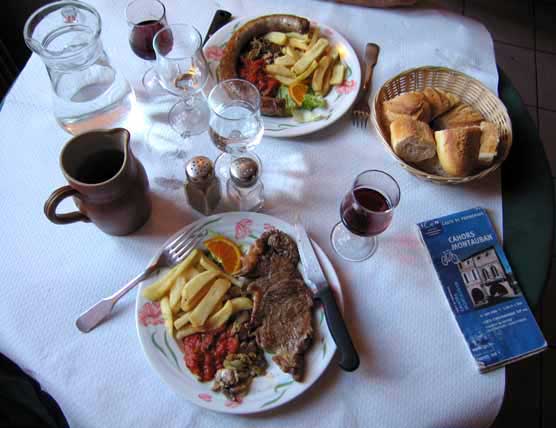
We had a glass of rosé in the bar, and drifted through the glass doors into the dining room when our fellow drinkers did. They were a rough-looking lot, mostly truck-drivers, who evidently knew each other and ate here regularly.
We got a table by the window, looking out onto the highway, and ordered the €13 menu. This turned out to be one of the mightiest banquets we had ever been faced with.
It began with a tureen of delicious fish soup, complete with croutons, grated cheese and mayonnaise, then progressed to a buffet of crudités, eggs, snails, prawns and meats.
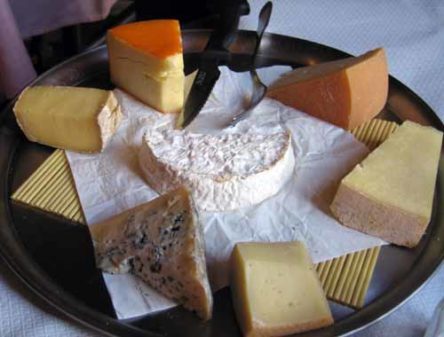
I had luckily remembered to bring a plastic bag, so most of this disappeared for tomorrow’s lunch.
The main course was a thick slab of steak for me and a foot-long sausage for Keith, with a garnish of vegetables, and we finished with three scoops of icecream for Keith (two is normal), while I got an array of cheese, some of which also went into the plastic bag.
Keith complained of indigestion in the night.
Previous section: Trébas to Puycelci